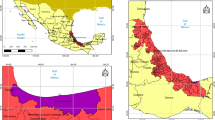Abstract
Thermal performance is the most important factor in the development of a borehole heat exchanger utilizing geothermal energy. The thermal performance is affected by many different design parameters and different operating conditions such as bleeding. This eventually determines the operation and cost efficiency of the borehole heat exchanger system. The thermal performance of an open standing column well (SCW) type geothermal heat exchanger was assessed under the influence of bleeding. For this, a thermal response test rig was established with line-source theory. The test rig also had a bleeding function by releasing fluid while taking additional underground water through the heat exchanger. The thermal response test was performed with an additional constant input heat source. Effective thermal conductivity and thermal resistance were obtained from the measured data. From the measurement, the effective thermal conductivity is found to have 1.47 times higher value when bleeding is applied. The thermal resistance also increases by 1.58 times compared to a non-bleeding case. This trend indicates enhanced heat transfer in the SCW type heat exchanger with a bleeding function. Bleeding, therefore, could be an effective method of achieving a high heat transfer rate in the SCW type heat exchanger with sufficient underground water supply.
Similar content being viewed by others
References
LEE J Y. Current status of ground source heat pump system in Korea [J]. Renewable and Sustainable Energy Reviews, 2009, 13: 1560–1568.
LEE S H, PARK J W, LIM K B. An experimental study on the thermal performance measurement of large diameter borehole heat exchanger (LD-BHE) for tripe-U pipes spacer apply [C]// Winter Proceeding of KSNRE. Jeonju, 2009: 581–586. (in Korean)
ZENG H, DIAO N, FANG Z. Heat transfer analysis of boreholes in vertical ground heat exchanger [J]. International Journal of Heat and Mass Transfer, 2003, 46: 4467–4481.
CUI P, YANG H, FANG Z. Heat transfer analysis of ground heat exchangers with inclined boreholes [J]. Applied Thermal Engineering, 2006, 26:1169–1175.
YANG W, SHI M, LUI G, CHEN Z. A two region simulation model of vertical U-tube ground heat exchanger and its experimental verification [J]. Applied Energy, 2009, 86: 2005–2012.
SHARQAWY M H MOKHEIMER E M, BADR H M. Effective pipe-to-borehole thermal resistance for vertical ground heat exchangers [J]. Geothermics, 2009, 38: 271–277.
OPPELT T, RIEHL I, GROSS U. Modelling of the borehole filling of double U-pipe heat exchangers [J]. Geothermics, 2010, 39: 270–276.
ESLAMI-NEJAD P, BERNIER M. Heat transfer in double U-tube boreholes with two independent circuits [J]. Journal of Heat Transfer, 2011, 33: 082801-1–082801-12.
AL-KHOURY R, KOLBEL T, SCHRAMEDEI R. Efficient numerical modeling of borehole heat exchangers [J]. Computers & Geosciences, 2010, 36: 1301–1315.
LEE C K, LAM H N. Computer simulation of borehole ground heat exchangers for geothermal heat pump systems [J]. Renewable Energy, 2008, 33: 1286–1296.
CARLI M D, TONON M, ZARRELLA A, ZECCHIN R. A computational capacity resisyance model (CaRM) for vertical ground-coupled heat exchangers [J]. Renewable Energy, 2010, 35: 1537–1550.
SHANG Y, LI S, LI H. Analysis of geo-temperature recovery under intermittent operation of ground-source heat pump [J]. Energy and Buildings, 2011, 43: 935–943.
GUSTAFSSON A M, WESTERLUND L. Heat extraction thermal response test in groundwater-filled borehole heat exchanger-Investigation of the borehole thermal resistance [J]. Renewable Energy, 2011, 36: 2388–2394.
CLAESSON J. PC design model for thermally interacting deep ground heat exchangers [R]. IEA Heat Pump Centre Report HPC-WR-8, 1991: 95–104.
HELLSTROM G, SANNER B, GONKA T, MARTENSSON S., Experiences with the borehole heat exchanger software EED [C]// Megastock Conference. Sapporo, 1997: 247–252.
LIM K B, LEE C H, LEE S H, SOUNG N W. An experimental study on the thermal performance measurement of vertical borehole heat exchanger (BHE) [J]. Journal of KSME, 2006, 30(8): 764–771. (in Korean)
SOHN B H. Evaluation of ground effective thermal conductivity and borehole effective thermal resistance from simple line-source model [J]. Journal of SAREK, 2007, 19(7): 512–520. (in Korean)
LIM K B, LEE S H LEE C H. An experimental study on the thermal performance of ground heat exchanger [J]. Experimental Thermal and Fluid Science, 2007, 31: 985–990.
JEONG Y M, KOO J M, HWANG Y J, JANG S Y, LEE Y H, LEE D H, AND LEE, J. K. Measurement of ground thermal conductivity and characteristics of thermal diffusion by the ground heat exchanger [J]. Journal of SAREK, 2008, 20(11): 739–745. (in Korean)
LEE S K, WOO J S, KIM D K. A study of determining initial time of line source model used in estimating the effective soil formation thermal conductivities [J]. Journal of Energy Engineering, 2008, 17(3): 167–174. (in Korean)
EKLÖF C, GEHLIN S. TED; A mobile equipment for thermal response test [D]. Sweden: Luleå University of Technology, 1996.
MOGENSEN P. Fluid duct wall heat transfer in duct system heat storage [C]// Proceedings of International Conference on Subsurface Heat Storage in Theory and Practice, Stockholm, 1983: 652–657.
ESKILSON P. Thermal analysis of heat extraction boreholes [D]. Sweden: University of Lund, 1987.
LOUIS L, BENOIT B. A new contribution to the finite line-source model for geothermal boreholes [J]. Energy and Buildings, 2007, 39: 188–198.
DENG Z, REES S J, SPITLER J D. A model for annual simulation of standing column well ground heat exchangers [J]. HVAC&R Research, 2005, 11(4): 637–655.
Author information
Authors and Affiliations
Corresponding author
Additional information
Foundation item: Project supported by the Second Stage of Brain Korea 21 Projects and Changwon National University in 2011–2012
Rights and permissions
About this article
Cite this article
Choi, Hk., Yoo, Gj., Lim, Kb. et al. Characteristic analysis of bleeding effect on standing column well (SCW) type geothermal heat exchanger. J. Cent. South Univ. 19, 3202–3207 (2012). https://doi.org/10.1007/s11771-012-1396-4
Received:
Accepted:
Published:
Issue Date:
DOI: https://doi.org/10.1007/s11771-012-1396-4




